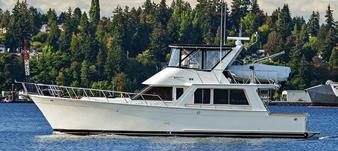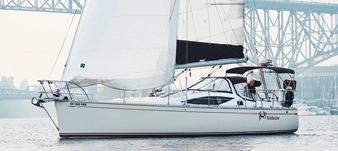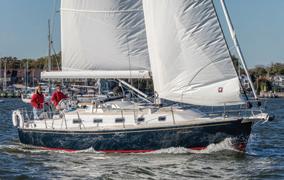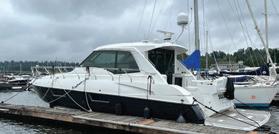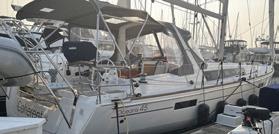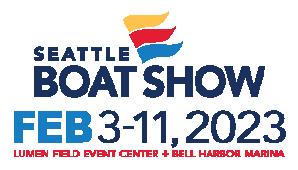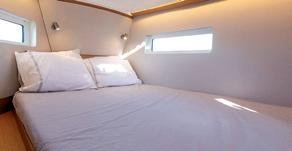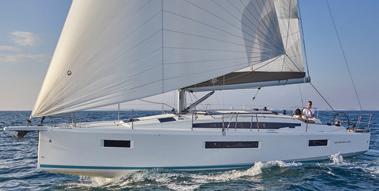






































MKIV Furlers are one of the most popular products in the Harken product line for racing. Harken now offers MKIV

OCEAN built with MKIV quality but configured for the cruising sailor. For the occasional racer, the MKIV line is engineered with ease, durability, and winning in mind.

# Multiple rows of Torlon® ball bearings in high-load areas minimize friction.
# Stacked bearing races evenly distribute radial and thrust loads; drum and halyard swivel turn freely under load.

# Foils rotate around headstay so headstay load is isolated from the furling unit for easy furling.
# Large inner spool diameter increases mechanical advantage for powerful reefing and furling.
# Aluminum line guard, torque tube, and swivels deep saturation hardcoat anodized, UV-stabilized for durability.
# Line guard polyurethane coated for wear protection.
# Specially formulated low stretch black line is abrasion and UV resistant; standard on units 0, 1, 2.
# Aerodynamic (MKIV) and round (MKIV Ocean), clearanodized aluminum foils handle extreme reefing loads.
# Triple interlock foil joints withstand years of torque loading: foil connectors geometric shape interlocks with foil; secures with syringe injected adhesive; screws provide final lock.

As sailors go, I’ve never really been a knot guy. I did learn to tie a monkey’s fist when I was a teenager, but I know and use only the tiniest fraction of the vast number of cool, useful, and sophisticated knots that could be available to me. I was reminded of this recently when I was tapped to lead a “Practical Knots for Regular People” session at a staff retreat. It was surprisingly fun, and it led me to a metaphor about getting into boating.
This month, future boaters will be strolling red carpets and docks at the boat shows in Vancouver and Seattle. As we all are, they will be wooed by sexy lines of design, wowed by elegant interiors, and full of wonder about the dreams and possibilities that boats and the boating lifestyle so uniquely inspire.
Many of these new boaters will also be struck by just how much there is to learn. They will be bombarded by all of the nautical language, the lingo of design and construction, the scope of systems, the basic mechanics and safety when using a boat, how to navigate, where to go, and what to do if you get into trouble… It can be extremely daunting and there’s a risk that these someday-boaters could quickly feel that they’ll never get up to speed and don’t belong. Even those who have been boating for a while may be given to imposter syndrome when interacting with the significant amount of expertise on offer at a boat show.
That’s where my knot reflection comes in. The traditional authority for rope-tying enthusiasts is The Ashley Book of Knots, which boasts nearly 3,900 hundred knots between its covers, and those are only the “practical” ones collected and documented by Clifford Ashley. That’s a lot of knots! A person could assume that in order to be an adequate and self-sufficient sailor, you’d better know them all.
Sheesh, for my retreat session, I pulled out all the stops and taught pretty much everything I know. The number of knots was six — bowline, figure-eight, square knot, cleat hitch, clove hitch, round turn and two half-hitches, and a few of their variations (I spared my colleagues the monkey’s fist).
I was anxious in advance of the session, fully aware how little I know about knots. When I began to share the knowledge I did have, though, I found myself encouraging the attendees that if you know these knots, you can adjust them or add to them and get the job done in situations where another knot (that I don’t know) might be ideal. And more importantly, if you know these knots, you can have a lifetime of fun on the water.
I’m living proof. I am proud to be a proficient sailor with decades of experience in my wake. I have cruised quite a lot, captaining boats around the Pacific Northwest and in Europe. I have raced at a respectable level on dinghies, sport boats, and 50-footers. I have taught sailing and coached racing techniques. And through all of that, I have gotten by just fine with six of Ashely’s 3,900 knots.
While I’d love to know more knots and apply them when they provide more perfect or elegant solutions than the handful I use repeatedly, it is important to acknowledge all that one can achieve with limited knowledge. This is possible because the skills I possess are some of the most essential, but also because I’ve learned how to modify and adapt what I know effectively in real-life situations.
No doubt, foundational understandings and skills are necessary to stay safe on the water, and are a real and fair prerequisite. But it is crucial to help those who are new to boating realize that they don’t need to know it all before they begin. And once you know a little, there's a heck of a lot of fun to be had.
Please visit us at the Seattle Boat Show (booth W2)!
Volume XLII, Number 7, February 2023
(206) 789-7350 info@48north.com | www.48north.com
Publisher Northwest Maritime Center
Managing Editor Joe Cline joe@48north.com
Editor Andy Cross andy@48north.com
Designer Rainier Powers rainier@48north.com
Advertising Sales Kachele Yelaca kachele@48north.com
Classifieds classads48@48north.com
Photographer Jan Anderson
48° North is published as a project of the Northwest Maritime Center in Port Townsend, WA – a 501(c)3 non-profit organization whose mission is to engage and educate people of all generations in traditional and contemporary maritime life, in a spirit of adventure and discovery.
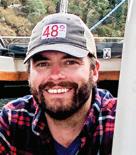
Northwest Maritime Center: 431 Water St, Port Townsend, WA 98368 (360) 385-3628
48° North encourages letters, photographs, manuscripts, burgees, and bribes. Emailed manuscripts and high quality digital images are best!
We are not responsible for unsolicited materials. Articles express the author’s thoughts and may not reflect the opinions of the magazine. Reprinting in whole or part is expressly forbidden except by permission from the editor.
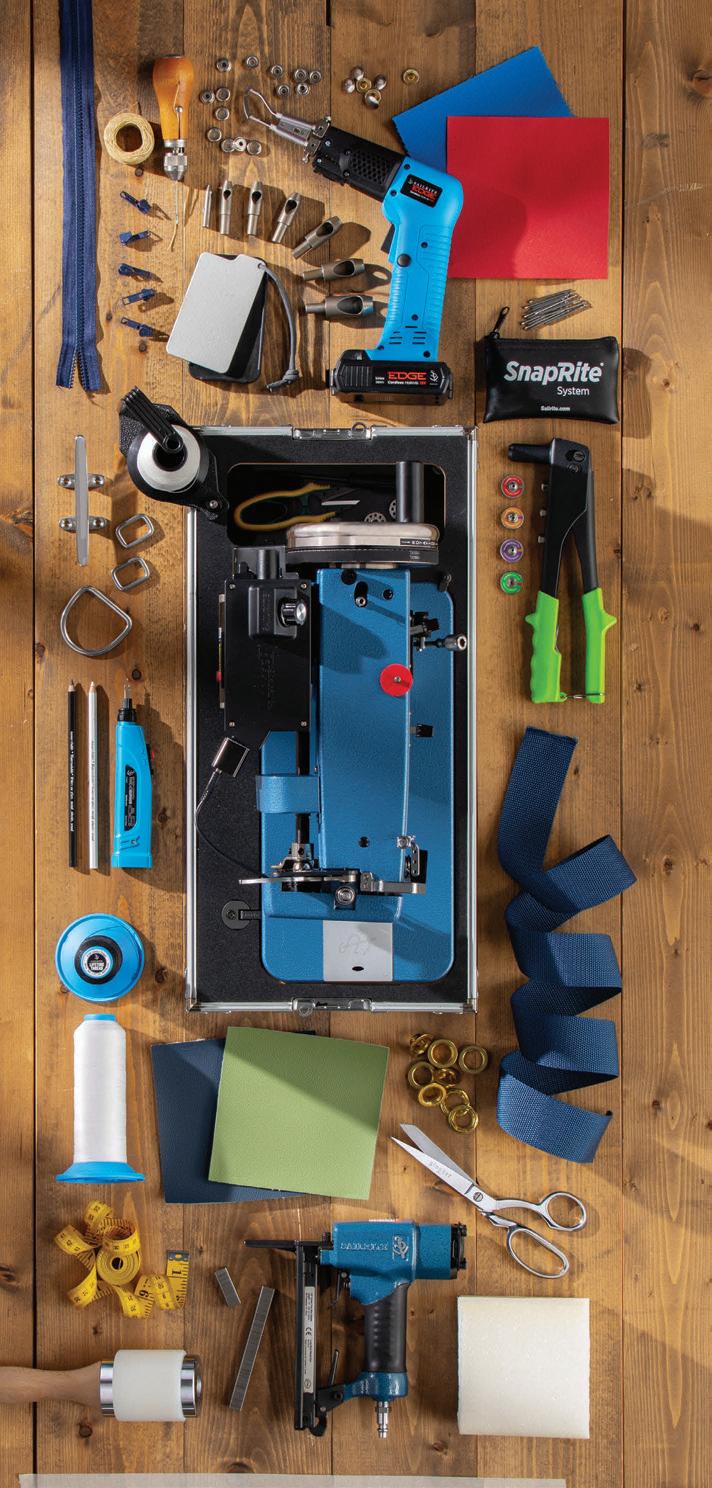

As most readers know, 48° North has been published by the Northwest Maritime Center (NWMC) since 2018. We are continually amazed by the inspiring and important work of our colleagues and organization, and are excited to dedicate this page to sharing a bit about it with you. This page affirms that 48° North is part of something bigger, and that we think the missionminded efforts of our organization matter to our readers, and are good for this community and publication.
It's pretty amazing that an organization and facility that trains professional pilots on a simulator, hosts the continent's largest wooden boat festival, and facilitates immensely popular adventure races, can also provide exceptional summer camp fun and education for young people. Recently, registration for nine weeks of summer day camps in Port Townsend opened for the 2023 season. But what are these camps all about?
For the younger kids, it begins with play. All offerings for ages 5 to 10 years old are "Messing About in Boats" camps, and they are every bit as worthwhile as the Water Rat would suggest.
Lil Scuppers is NWMC's maritime summer camp for the youngest campers, ages 5–7. Kids start with a morning circle, reading or singing. Afterward, they get out on the boats (weather permitting). They might row, sail, or drive a power boat. It's a joy to see a 6-year-old's face light up when they realize they are the one steering the boat! Campers also explore the area beaches and enjoy scavenger hunts.
For young people between 7 and 10 years of age, the Junior Discoverers camps provide a multitude of ways to experience maritime life in a fun, hands-on way. They enter the maritime world by exploring the beach, heading out to sea in rowboats, powerboats, and sailboats, and learning about the creatures that live in and around the sea — they even get to spend one day at the Marine Science Center. It's not your typical summer camp!
For older kids, the pathway is more structured with the goal of learning to sail, but it's just as fun! These camps broaden in

EVENTS CALENDAR » www.nwmaritime.org/events
R2AK TAILGATE PARTY
Feb. 4
901 Occidental Ave S, Seattle
RADAR AND COLLISION AVOIDANCE
Feb. 18
Northwest Maritime Center
their offerings, helping different ages and families experience the rich rewards of sailing. Three skill tiers — beginner, intermediate, and advanced — help kids enjoy and understand the process of progression and skill development. Within these levels, camps are offered as partial days or "intensive" full-days, and there are some learn to sail camps just for girls. Learn to sail camps get kids sailing in Optimist and/ or Flying Junior dinghies, with the chance to try out 420 dinghies as they advance.
NWMC is proud to offer scholarships to those facing financial barriers, youth service organizations, schools and underserved youth, so everyone can have the opportunity to learn about the maritime world, regardless of financial circumstances. To apply for a scholarship, please complete the scholarship application form during the registration process. If you are in a position to pay more than the suggested price, additional funds will contribute directly to making youth programs more widely accessible.
» nwmaritime.org/programs/youth-programs/youth-summer/
NO IMPACT DOCKING Feb. 28 - March 1
Virtual Class
MARINE THRIFT SWAP MEET April 1
Marine Thrift 315B Haines Pl., Port Townsend
MARCH 11, 2023, 6 P.M.
Hilarious and heartbreaking, raw and brutally honest — She Tells Sea Tales offers an intimate glimpse into the lives of women in the maritime industry.
This beloved annual evening of sea stories, told by the women mariners who have lived them, inspires, empowers, and connects women from across all waters.
For the first time since 2019, She Tells Sea Tales will be held in person at Northwest Maritime Center in Port Townsend. Accordingly, tickets are limited, and they always sell out.
Six women will share their stories — they are seafarers, adventurers, maritime professionals, and business owners. All of them have known highs, humor, and hardships on and near the water, and have important and impactful tales to tell.

Keep an eye out for more details. Tickets, which are $30, go on sale soon.
» nwmaritime.org/shetells





























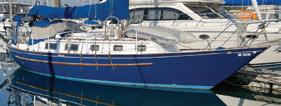














Dear 48° North,
Thanks for running the article on the Foulweather Bluff race and protest. As one of the 20 protested and disqualified boats, I wanted to make a couple of observations.
First, I am in 100% agreement with the decision that all the protested boats be disqualified. I believe that it is critical that the yacht clubs and the racing community show the USCG that they take safety seriously, and that “bad behavior” will be penalized. (Even though some of the boats DSQed would have been clear of the shipping lane before the freighter would have got there if she had maintained speed and course.)

The big problem is that if any lesson was learned from the incident, it was the wrong lesson. The article mentioned “an unfortunate set of unpredictables.” The timing of the freighter was certainly unfortunate and unpredictable, but given the geometry of the race course, and the reverse start sequence, the outcome was absolutely predictable. If those circumstances were to occur again in a couple of years, exactly the same thing will happen — the fact that 20 boats were DSQed in 2022 will not change future outcomes.
There were two underlying problems. The first is that the boats were on a layline spinnaker reach from Foulweather Bluff to Scatchet Head, and that layline crossed the southbound lane at a pretty flat angle. The freighter was still several miles back when he bailed out and did a 360. Depending on his speed, it would have taken 10-15 minutes for him to overtake those 20 boats. To open the southbound VTS lane would have required all those boats to run dead down and/or jibe back towards Kingston and sail away from the mark for 10-15 minutes. Clearly that would never happen in the real world.
The second problem is that boats were densely packed together in the VTS lane. The complaint report from the bridge of the bulk carrier specifically stated that he was blocked by a solid wall of boats. He further stated that he looked for a hole, but there wasn’t one. I see this as the result of running a reverse start, which creates a denser pack of boats as the fast boats starting last sail through the slow boats that started first — the fleet effectively turns itself inside out and condenses while that happens. The same problem has occurred when a race is sailed around Blakely Rock using a reverse start. A solid wall of boats moves across the lane for the Winslow ferry, which in the past has blocked it and caused a ferry to come to a stop and wait for the fleet to pass.
Until and unless the local clubs stop using reverse starts, and stop setting courses that result in the fleet being on a layline running through a VTS lane at a flat angle, this problem will unfortunately occur again in the future.

Johnson Quest 30 Charlotte










The 76 th annual Seattle Boat Show is set to sail into town on Friday, Feb. 3 and through Saturday, Feb. 11. This year’s show will feature nearly 300 exhibitors with more than 800 new and brokerage boats — indoors at Lumen Field Event Center and on the water at Bell Harbor Marina — and the latest in marine accessories and technology. In addition to being a place to shop for the boat of one’s dreams, the show has always been a celebration of boating and a place for boaters to rendezvous with friends, plan for summer adventures, and have some fun. Here are some of the highlights coming this year:
Wine Down at Uncorked, the Seattle Boat Show’s Opening Night Event — Friday, Feb. 3 Chardonnay and a Cobalt. Sauvignon Blanc and a SeaRay. Merlot and a Malibu. These pairings will all be available at Uncorked, Seattle Boat Show’s opening night event! Souvenir glass can be purchased for $8 inside Lumen Field Event Center and includes your choice of wine.
Massive Rube Goldberg-inspired Boating Machine — All show days
Over the course of the nine days of the show, Zach Umperovitch, the world’s leading authority on Chain Reaction Machines and two-time Guinness World Record holder, and Co-Host of Discovery Channel’s “Contraption Masters,” will invent and construct a Rube Goldberg-inspired machine for boaters, using boat-related items. Showgoers can stop by anytime to chat with Zach, watch him in action, and even make suggestions on materials to use. At 4 p.m. each day, Zach will start the machine to demonstrate the progress.
Women’s Day — Monday, Feb. 6
Women can attend the show for free and enjoy a slate of seminars designed specifically for women, by women boaters. It’s the perfect opportunity to meet, learn and get inspired by some of the most talented women boaters around. The special Women’s Day pass is available on the show’s website.
On-Water Rescue Dog Demo at Bell Harbor Marina — Wednesday, Feb. 8, 3 p.m.
Water rescue dogs from the American Academy of Canine Water Rescue, a nonprofit organization that breeds and trains dogs to perform water rescues, will be at Bell Harbor Marina
with Newfoundlands Oakley and Angel to demonstrate their impressive cold water rescue skills. These specially trained dogs can tow up to 5,000 lbs and are taught to jump from search and rescue helicopters. Showgoers can also meet Oakley and Angel at Lumen Field during Dogs on Deck on Thursday, Feb. 9.
on Deck — Thursday, Feb.9
There’s a special day at Lumen Field Event Center just for furry first mates. Dogs accompanied by their owners can stroll the red carpets, meet and greet with dog trainers, get a photo in the Photo Booth, have a custom dog tag made, and sniff out their favorite boats. Note: dogs need their own (free) ticket which can be obtained at the show's website.
Sails & Ales Craft Beer Night Friday, Feb. 10 Drink in the hops and props at the Seattle Boat Show’s Sails & Ales craft beer night. Enjoy a PNW beer in a souvenir glass for just $8 while shopping for the boat of your dreams.
Boating and fishing seminars — All show days
Entertaining and educational, the seminars are always one of the most popular features at the show. For 2023, there will be 110 hours of seminars, of which 25% are new. The boating and fishing seminars can be attended in person and, with a special Seminar Package ticket, are viewable online for three months post-show. Boat Show U webinars are available in person and online for those who purchase a Seminar Package ticket.
Young sailors and their families are invited to stop by the Youth Boating Center to start their boating adventures. Offering an introduction to sailing, STEM, and the marine world, the staff at the Youth Boating Center will educate kids and families on the wind, propulsion, local sailing opportunities, knot tying, and more through fun hands-on activities.
Tickets:
$20 Adult Ticket
$40 Multi Day Ticket, good for all 9 days of the show
$119 Seminar Package
Free: Kids 17 & Under A free shuttle runs between both show locations.
» www.SeattleBoatShow.com

Seattle area boaters are invited to attend CYC's Friday evening speaker series. It is a fun way to spend winter evenings with food, drinks, and friends, and inspire your own adventures.
Friday, Feb. 3 – Bareboat Charting in the British Virgin Islands with presenter Elly Cyr. Elly was part of two allfemale charters in the BVI in 2017 and 2022. Elly will share fun stories and lessons learned, as well as her favorite places to visit, provision, eat, and drink while cruising those tropical waters.
Friday, Feb. 10 – Final Two Legs of the Clipper Round the World Race with presenter Lizzy Grim. Lizzy will share her adventures sailing with the Clipper from Seattle to Panama, through the Canal, and to New York; before an epic North Atlantic crossing to Northern Ireland, then to the finish in London.
Friday, Feb. 17 – First Time Cruising the Gulf Islands with presenters David and Gyung Huntsman. In 2022, David and Gyung sailed their J/37 Lolo to Canada, where they spent the next 16 nights exploring the Gulf Islands. They will share what they learned and recommend for other cruisers.
Friday, Feb. 24 – Adventures Afloat & Aground with presenters Wendy Hinman and Garth Wilcox. Wendy and Garth share their story sailing 34,000 nautical miles aboard their 31-foot cold-molded sailboat, Velella. They will also talk about the 38-foot sailboat they are building in their backyard. $10 admission for non-members, please pre-register. » www.cycseattle.org
Hobie Cat Company has appointed Starting Line Sailing as the new worldwide supplier for all Hobie Sailboats and Genuine Hobie Sailboat Parts and Accessories. This partnership will ensure continued investment in the production and availability of products enjoyed by thousands of sailors around the world. The same dealers and agents will stay involved, and the International Hobie Class Association will continue to coordinate and organize racing and events for Hobie class catamarans.
40 Years ago, Hobie Alter created a brand new type of sailing: beach cat fun for everyone. And that deep legacy, heritage, and vision continue with this partnership. Hobie and Starting Line Sailing — the parent company that includes Portland's West Coast Sailing, Zim Sailing, and several other companies — will work together to support the dealer network and the community of those interested in sailing and racing Hobie class catamarans. Direct coordination with the International Hobie Class Association will ensure ongoing support for the Hobie World Championships and the many famous Hobie events loved by sailors around the world.
» www.startinglinesailing.com

Port Townsend’s historic 50-slip Point Hudson Marina has opened again for boaters as of Wednesday, Jan. 25, 2023 — weeks ahead of schedule. Port of Port Townsend Executive Director, Eron Berg, said efficient work by Orion Marine Contractors of Tacoma, with strong support by the Port staff, made the early completion possible.
Point Hudson is protected from southerly winds by two jetties, both failing after almost 90 years of service. The 20222023 project, which began in mid-September, replaced the shorter north jetty. In September 2023, Orion will return to replace the longer south jetty and its pedestrian walkway.
The steel piles of the new jetty were driven 30 feet into the bottom of Port Townsend Bay before being filled with rock. Over 4,000 tons of armor stone fills the new north jetty at Point Hudson Marina.
“Orion did a great job, and the Port’s team did its work, keeping an eye on environmental compliance,” said Berg. “It went as well as we could expect for season one."
While most of Point Hudson has reopened, one portion of it — the six 70-foot guest moorage finger piers closest to the new jetty and to the RV Park — will remain closed for a few more weeks. Even with work continuing, Berg said the new jetty is intact and does its job of protecting the marina. Transient boaters are welcome to return, said Berg. “Come on in,” he said. “Have some dinner and some fun in town.”
» www.portofpt.com
Seattle Singles Yacht Club recently donated the proceeds from their Northwest Harvest Race, dinner, dance, and auction to Northwest Harvest — a non-profit that works toward food justice through collective action. Join the fun and support the cause by sailing the Northwest Harvest Race on September 23, 2023. » www.seattlesinglesyc.com/

The Sailing Foundation will be hosting US Sailing International Offshore Hands-on Safety at Sea Seminars on Sunday, March 5, and Sunday, March 19, 2023. In-person Safety at Sea trainings are for everyone — cruisers, powerboaters, sailboat and adventure racers — but the demand is especially high among offshore sailors, since many races require the certification for a portion of the crew. Bruce Brown will be the US Sailing moderator on both dates.
A critical note: these will be “hybrid” courses. Participants MUST purchase and complete the online prerequisite course and provide their certificate of completion two weeks before attending the hands-on training. First-time students need to complete the full online coursework. Those renewing a certification (issued within 10 years) have a condensed "refresher" set of online modules.
Two available dates/locations for hands-on training: Sunday, March 5 at Bainbridge Island High School/Pool, WA Sunday, March 19 at Marshall Center, Vancouver, WA


Cost for the hands-on training is $300 per person. Cost for the online prerequisite is $150.
» www.thesailingfoundation.org/what-we-do/safety-at-sea
» www.firsttack.org/courses/safety-at-sea-offshore
The third installment of the 2022-2023 Southern Sound Series, the Toliva Shoal Race, is ready for launch this month. Hosted by Olympia Yacht Club and the South Sound Sailing Society, the unique course brings sailors from Olympia, past the Nisqually Delta, around the Toliva Shoal buoy, and back on the far side of Eagle Island. The total distance is 38.4 miles. There's still time to register and join the fun!
» www.ssssclub.com/ssseries/
CHANGE: West Sound CYC's Taking Care of Business Regatta will be May 20 (not May 21).
ADDITION: The Moore 24 Pacific Coast Championship hosted by Hood River Yacht Club takes place July 28-30, 2023.
ADDITION: Lake Chelan Regatta is on Sept. 9-10, 2023.
» www.48north.com/SARC
Ranging from 26' - 50', able to live "off the grid" for up to 3 days and easily moored in a marina. Equipped with twin OB engines and steering station, or as a barge. Several models to choose from, custom interior layouts, custom finishes, and more.



It might be time to finally ditch your old school flares. The Sirius Signal C-1002 two-color electronic Visual Distress Device (eVDSD) is the world’s first marine safety electronic flare to meet the new USCG safety standard. Incorporating 13 LEDs, the C-1002 is five times brighter than any approved device on the market. The C-1002 includes the Sirius Signal App for iOS and Android cell phones, allowing users to perform system checkups or provide instantaneous SOS notifications and location to first responders, towing services, and other designated contacts. With a full charge, the C-1002 will provide six hours of runtime, four hours more than is currently required. The US Coast Guard Compliance Kit includes the light, a flag, whistle, and batteries.

Price: $299 » siriussignal.com
Whether you’re day-sailing dinghies or are sitting on the rail during chilly long distance races, a quality drysuit can be a great choice in the PNW. Gill Marine’s new Verso Drysuit features their patented XPLORE+® three layer fabric and XPEL® plant-based treatment for exceptional waterproofness and breathability. The Verso is designed to keep you comfortable and protected all day with rear-entry through a heavy duty, durable TIZIP® MasterSeal waterproof zipper to keep the bulk away from your chest, plus a waterproof relief zip on the front. Laser-cut face ventilation, inner neoprene dryseal gaskets at the neck and cuffs, and an adjustable overskirt help refine the fit. A key feature of Gill’s new drysuit is the integral hood with two way adjustment, which can be easily stowed out of the way to ensure your performance is not impacted.

Price: $850 » gillmarine.com
Specifically designed to display all the crucial sailing data you need, the B&G Nemesis is an ideal solution for racers or performance-minded cruisers. Showing wind speeds and directions, depth, boatspeed and other data, the Nemesis features context modes including upwind, reaching, downwind, and pre-start. Mounted either on the mast, in the cockpit, or at the helm station, the super bright touchscreen with adjustable data sizes, palettes, and backlight provides outstanding visibility from wherever you are on the boat and in all conditions. The Nemesis display is also completely customizable, allowing you to choose from pre-set templates, set up automatic point of sail dashboards, or entirely create your own. The Nemesis comes in 9-inch and 12-inch models, and can be oriented in either vertical or horizontal positions.
Price: $3,799.99 » bandg.com







The world’s largest volcano (it’s inactive) was recently discovered on the floor of the Pacific Ocean about 1,000 miles east of Japan. Called Tamu Massif, it’s about the size of New Mexico, and is 60 times bigger than Hawaii’s Mauna Loa, the world’s largest active volcano.
In 1993, scientists discovered the largest known concentration of active volcanoes on the seafloor in the South Pacific. The size of New York State, it contains more than 1,100 volcanic cones and seamounts.
The highest tides in the Pacific, up to 30 feet, occur near the Korean peninsula; the lowest, one foot, near the Midway Islands.
In 1929, author Zane Grey landed a 1,040-pound blue marlin in Tahiti, the first grander (a fish over 1,000 pounds) ever landed on rod and reel. A similar record was set with a 1,036-pound tiger shark in Australia.
lines or cables reaching from the rear of the vessel to the mast heads
Golf-club holder
Rotates from side to side about the fore-aft axis
When hatched, the giant Pacific octopus is the size of a grain of sand.
The deepest spot on Earth got protection in 2009 when the Marianas Trench Marine National Monument was established.
An unnamed mountain lying in the Pacific Ocean in a trench between Samoa and New Zealand is the world’s tallest completely submerged mountain. It’s 28,500 feet high, but its peak is 1,200 feet short of the surface.
More people have been to the moon than have been to the Challenger Deep in the Pacific, the deepest spot in the oceans.
The Pacific Ocean is five times wider than the moon.
More than 17 Arctic Oceans could fit into the surface area of the Pacific.
The strongest earthquake ever recorded occurred in the Pacific Ocean, off the coast of southern Chile, in 1960.
Nine out of 10 earthquakes strike around the shores of the Pacific Ocean.

a boat can head into the wind and be driven, or lifted, forward like a vertical wing (although I know that Cross was referring to the miracle of what sailing does for our peace of mind). But because of various realities of physics, that driving force also produces a heeling effect in strong breezes.
It’s always alarming and unnerving to hear objects falling from their stowed location in the cockpit or cabin as the wind unexpectedly jumps up a few knots. Even if we were to anticipate the shifting gravity of a hard heel for cabin items, and either anchor them in place or remove them altogether, we’d still have to brace our bodies as they heavily lean toward the drowning toe rail — a situation that is uncomfortable for passenger and vessel alike.
As new sailboat owners, my wife Laura and I are mostly fairweather mariners — a fact I hate to admit in the company of experienced sailors. We have yet to adjust to the often freezing wind chill factor of Pacific Northwest winters and the power of the accompanying storm systems that occur during those months. As a result, Ariel , our Columbia 28, rarely leaves her moorage at our local marina during the winter season.
When we do encounter a day with mild temperatures and excessive breeze, we may venture out onto the Salish Sea; joining the seasoned sailors who are unfazed, or perhaps even beckoned, by heavy weather. On that day, you can bet Ariel’s mainsail will be reefed and her headsail at least partially furled.
Some degree of heeling on a sailboat is desirable, as it comes with increased boatspeed. But once the boat heels too much, speed starts to decrease and
control becomes a challenge, which is when reefing is necessary. Reefing the mainsail can provide some balance and control, especially for day-sailers like us and even for experienced sailors like our dockmate, Fred. After nearly 50 years on the water, Fred advises us that, “The time to reef is when you first think about it.”
Before I begin to think of managing Ariel in high winds, I am still learning to trim the sails effectively in light breezes. While I try to get the most out of our old sloop, maximizing speed is not really the goal of our afternoon outings. We’re still at the honeymoon phase of gentle breezes on warm spring days, when we find ourselves harmonizing to the lyrics of Chistopher Cross’ hit song, “Sailing”: “
It’s not far down to paradise, at least it’s not for me./ If the wind is right, you can sail away, find tranquility./ Oh the canvas can do miracles, just you wait and see.”
“The canvas can do miracles.” Well, it is kind of miraculous and amazing that
So while we have yet to reef the main mostly because we are, dare I say, a little too chicken to take Ariel out in foul weather, we have tried to understand it and received instructions on the method from experienced sailors. And my takeaway is curious.
The whole process almost seems like cheating, or at least like a life-hack; sort of a “here’s what ya’ do when things get a little crazy.” Laura and I have always felt that if things get a little crazy, you shouldn’t be doing what you’re doing, or be in a place where you’re not supposed to be.
As much as we try to adhere to this advice, we are constantly reminded that the weather can turn on a dime in the Pacific Northwest, and things can get ugly fast, even if they started out nice and easy. The real challenge lies in knowing what to do when this happens, starting with sail areas.
While it is obvious that reefing the main reduces its surface area, and thus, the impact of power and drag from the wind — I wasn’t clear on exactly how much reduction occurred until I did a few calculations based on one of the

geometry lessons that I presented in my high school math classes, by starting with some known quantities.
Ariel’s mainsail is about 30 feet tall, with the first reef point lowering it to about 26 feet, and the second one to about 22 feet. I wondered what percentage of the sail is exposed at each of the two points.
I could find the area of the fully hoisted main, and the resulting areas of the reefed sail, but mathematics is all about creating a theorem to generalize findings for any value. The concept that I utilized deals with comparing the areas of similar shapes, that is, figures that have the same ratios of length to width — in layman’s terms, shapes that result from being reduced or enlarged on a copy machine.
To illustrate the concept, consider what happens to a simple shape, like a square, when its dimensions are changed. Starting with a 10-inch by 10-inch square, imagine what happens to its area when its lengths are reduced to a 7 by 7 square or to 70% of its original lengths. The large square has an area of 100 square inches. The 70% square has an area of only 49 square inches (7 times 7), which is a little less than half of the starting value, an ostensible paradox, but also a proven theorem.
The theorem that supports this result says that the change in area between two similar shapes, like the full-sized main compared to its corresponding reefed form, is found by multiplying the percent change not just once, but twice (known mathematically as “squaring” the quantity), required because both the length and width have changed. For the example dealing with the square, the new area was 0.70 times 0.70, times the original area.
The effect on areas of shrinking or enlarging shapes is an often overlooked and misunderstood concept. In all of the years that I presented the idea in my classes, I felt that I was rarely able to solidify the relationship for my students. I think that our brains are hard-wired for linear, or one dimensional, thinking more easily than two or three dimensions.
So it’s easy to see that Ariel’s first reef point is about 87% of the original height (26 divided by 30). And as the second lowers it another 4 feet or so, the resulting height is about 73% of the full height (22 divided by 30). But the associated areas, crucial for reducing the wind pressure on the sail, are not so easy to conceptualize.
Nevertheless, I couldn’t prevent my teaching brain from kicking into gear to determine just how much of the mainsail is exposed at each of the two reef points. I realize, of course, that in the scheme of a pleasant day on the water, it’s not really numbers and calculations that matter,
It may not seem so by looking at it, but the author's mathematical formula shows that the first reef point reduces sail area to 75% of the original, the second reef reduces it to 53% of its full sail area.
substantial change for only a four foot drop, and one that can reduce the heel and instability of Ariel to something manageable.
For the second reef point, at 73% of the height for the eight foot drop, the new area would be 0.73 times 0.73 times the full sail area, or about 0.53. So the second reef point produces a sail that is only 53% of the fully hoisted main! No wonder reefing is an effective method to utilize in high winds.
The beauty of mathematical formulas is often a double edged sword. While theoretical formulas provide a way to model the real world, they often oversimplify results and require empirical observations and experimentation to “force” them into compliance with practicality. Sail sizes (especially jibs and genoas) are usually not proportional. (For example, Ariel’s genoa possesses the same forestay height as the jib, but its foot is 1.5 times longer. The geometric theorem then, does not apply.) Even the roach of a mainsail will render the results of the calculation inaccurate. But even if producing an approximation, mathematical formulas can shed some light on lots of life, including boating procedures and specifically in reefing the main.
unless you’re talking heeling angle. And even then, it’s not really degrees of tilt; it’s degrees of relative comfort.
Allowing my exploration of the similar figure geometry theorem, I can conclude that the ratio of the area of the fully hoisted main to its size at the first reef point is 87% of 87%. That is, the reduced size is 0.87 times 0.87 of the full size, since the length of the sail at the boom is also reduced by an equal ratio (though not necessarily an equal length).
The resulting answer, 0.75, means that only 75% of the sail’s original, fully-hoisted area is experiencing wind pressure at the first reef point, a
As I learn to sail Ariel, my background as a math teacher allows me to view some of the events and scenarios through a fascinating, but perhaps oversimplified lens. Although I must admit that when we are in the midst of a sailing application under stressful conditions, I never have the temerity to mention the mathematics of the occasion. At this point in our sailing lives, how to enjoy a relaxing day on the water is the only calculation or formula that I really care about.
David Casey is a retired math teacher and semi-professional woodworker and bass player. He plans on using his retirement to build a small sailboat and a kayak, and to explore the waters of southern Puget Sound.
Title photo byt Ken Douglas.
On a rowing trip from Seattle to Port Townsend, I was taking a break atop a bluff, looking out toward Whidbey Island, when I noticed a 18-foot, gaff-rigged sailboat utterly becalmed, but pointing north, the same direction I had been traveling. Suddenly compelled to see said boat, I hurried down to my rowboat and launched with a new purpose.

A short while later, I coasted up to the craft to find its captain calmly reading a book in the shade of his sail. Without a motor, he seemed content to bide his time until the wind returned. He exuded an imperturbable sense of tranquility, as if he belonged in that very spot. We exchanged names and pleasantries and asked about each others’ boats. As I departed, I handed my new acquaintance, Tim, a bag of homemade cookies.
A year later, I finally met Tim on land after posting a story on my blog about fabricating a crude home-made mast traveler for my new boat. Appalled at the high cost of importing a commercially made model from England, I was still obsessed with owning one. That was when Tim reached out to help. Not only did he live about 10 miles from my home, but he would be happy to make one for me. I was thrilled at Tim’s thoughtfulness and excited to have a new sailing friend nearby.
Tim joined my crew of sail and oar explorers, often showing up with a 12-foot fiberglass peapod. Despite its diminutive size, it had a tiny mizzen sail and a modest mainsail. And thanks to Tim’s boat handling skills and ability to read currents, the peapod often outpaced boats twice its size. At the end of a sailing session, Tim would often hang around, reviewing the day, modestly offering tips, or just studying our boats, on the prowl for improvements. I learned that tinkering and improvising a fix is one of his strengths.
When I was on the hunt for a slightly larger boat, I went alone to investigate a bargain before someone else snatched it up. The hull was beautiful, but the water and rot inside were off-putting. When I began to feel overwhelmed at the prospect of tackling this project, I called Tim. He sounded more excited about the boat than I did, and he was ready to advise.
“Did you bring a mallet,” he asked over the phone.
I was perplexed. “Why would I have brought a mallet? I’m here to buy the boat, not build it.”
“To understand how solid they are, you have to tap the planks and the keel,” Tim coached from 200 miles away. “What kind of tone do they make?”
Even after tapping away, I had a hard time deciding whether buying the boat was a good idea, or too risky.
“I’m sure we can fix it,” Tim said, exuding his typical positivity. His use of the word “we” gave me the confidence to make the purchase.
After the boat was mine, and I was flummoxed about how to tune the unfamiliar rig, Tim invited me to bring it up to his place. As I rolled into his driveway, I spotted my friend in his typical uniform of a collared shirt, Carhartts, and lace-up loafers. He gave an appraising look at the boat, and I could see that he was already relishing the challenge of adjusting it to perfection.
Tim is the type of person who is happiest when busy. In the decade’s worth of photos I’ve snapped of him in action, he’s generally doing something on a boat. The majority of the photos are blurred: Tim’s hands in motion tying a complex, useful knot, swinging a large tool box from a block and tackle into a second-story sail loft, or hefting a dinghy, turtle-like, onto his back.
Tim has been involved with plenty of big boats, personally and professionally. But his heart belongs to a string of small wooden boats, ranging from a fast but leaky Sparkman & Stephens racing

dinghy to a handsome Herreshoff rowing boat. This passion for small boats is likely the reason our lives keep intersecting, and for that I am thankful.
When I had a sabbatical from work and contemplated a voyage on the Inside Passage, Tim offered me the use of his favorite sailboat, Mr. Mallard. Intrigued by its cozy cabin and salty look, I was both excited and daunted. After all, Tim liked this boat so much, he had bought it back after selling it some years prior. Was I capable enough to take Tim up on the generous offer?
In the end, I decided on a boat I already owned. But when I planned a one-way instead of a round trip, Tim hooked my trailer to his truck and dropped me off 300 miles up Vancouver Island. On launch day I was paralyzed by nervous jitters, but he gently pushed me forward, patiently waiting while I thought of a thousand last-minute excuses to avoid getting underway.
I’ve tried to reciprocate Tim’s giving spirit, through rituals like an annual delivery of new nautical books. Tim is a

voracious reader with a special interest in boat stories, so when I can find a few tomes that he hasn’t read, I feel I’ve made a small step towards matching the knowledge and skills he has bestowed on me.
Still, I’ve come to realize that I can’t, and shouldn’t, try to balance the scales all the time. There can be joy in giving, as well as grace in receiving. I’ve tried to emulate Tim’s generosity by hosting new sailors on day trips, running a local smallboat listserv, and sharing what I know,


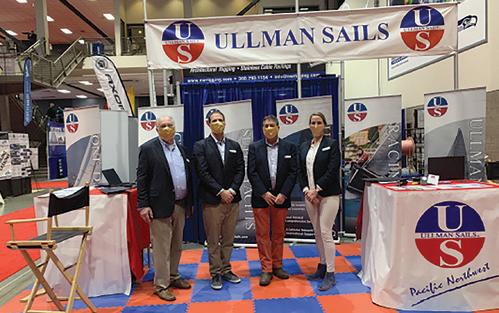

even if that’s a lot less technical than what Tim does. Freely shared knowledge and encouragement have been the best gifts I’ve received as a sailor. Passing them along to others brings satisfaction and a sense of wholeness. And who knows, I just might meet a new friend in the process.
Bruce Bateau sails and rows traditional boats with a modern twist in Portland, Oregon. His stories and adventures can be found at www.terrapintales.wordpress.com.


 by Bob Vizenor and Doug Lombard
by Bob Vizenor and Doug Lombard
Before dawn on a cool morning in late August, we slipped the dock lines and motored out of Elliott Bay Marina to join the Coho Ho Ho fleet on a voyage down the Pacific coast to San Francisco and beyond. Our crew of four watched the bright lights of Seattle fade behind us from the cockpit of the Beneteau Oceanis 45 with much excitement and not a little of trepidation. Making the turn north at West Point, we caught the start of the ebb tide running up Puget Sound and made good time with the current, gliding past the familiar landmarks of Kingston, Point No Point, Foulweather Bluff, and Port Townsend.
As organizers of the Coho seminar series and rally, we and the rest of our crew had been on the docks at Boat Haven Marina in Port Townsend a few days earlier for the official fleet sendoff. We asked for blessings from the gods of the winds and seas and ceremonially cut the last dock line holding the boats to the dock as they embarked on their adventures. Port Townsend is a convenient jumping off point with a grocery store and chandlery within easy walking distance from the marina, as well as lots of great shops, restaurants, and pubs to explore while waiting on favorable conditions to transit the Strait of Juan de Fuca.

When it was our turn to head for the Strait, the forecast was for calm weather, so we motored past Point Wilson and turned the bow west to continue our outbound journey. A few hours later, we pulled into the fuel dock at Port Angeles to top up the tanks. It was a quick in-andout for us, and we continued motoring west into a beautiful sunset.
We passed Neah Bay in the dark, shortly before midnight, and continued towards Cape Flattery to make the proverbial “Big Left Turn” into the Pacific Ocean. Many people anchor in the ample protection offered by Neah Bay to wait for good weather and rest up for the passage down the coast. If you spend a few days there, the fantastic Makah museum is a short walk from the marina; and if you’re passing through on a late August weekend, you can catch the Makah Days celebration.
Eager to make use of the gentle weather and excited to start making miles south, we passed Cape Flattery without ever seeing it as it was cloaked in fog and darkness. We swung wide around Tatoosh Island and set a course south toward our next planned stop in Newport, Oregon, being careful to stay well offshore to avoid the crab pots.
The easy up and down motion in the Strait had given way to a swell on the stern quarter, which resulted in the typical corkscrew motion of the boat in open ocean. One of our crew soon fell victim to the motion and retired to his bunk in hopes of relief.
I had the first night watch and kept an eye on the GPS and radar since there was zero visibility in the foggy dark. At 2 a.m., I handed the helm over to Captain Doug and turned in to get a little rest, hoping for wind in the morning so we could finally do some sailing. It had been a long first day and I fell into my bunk without bothering to take off my bibs.
Climbing back into the cockpit at 6 a.m., I found Doug still at the helm and our seasick crew member with his head over the side rail feeding the fish. The wind
filled in as the sun rose behind the fog and we set sails on a broad reach south — this was more like it. While the sailing brought us joy, seeing our fellow sailor in dire straits slightly dampened our enthusiasm. All day, we plied our sick crewmate with ginger tea, soda crackers, and other hopeful remedies. None of us had ever really been seasick before and, unfortunately, we had not brought along any medications just in case.
By afternoon, our crewmate was showing no signs of improvement and the wind had backed to the southwest, so we decided to alter our offshore course plans to make for Westport, Washington.
Fortunately, the conditions at the entrance bar to the harbor — with a dying flood before high slack — had wind, swell, and current all moving the same direction and afforded us an easy

and safe crossing when we arrived. Even though we had originally planned on a route farther offshore, we had printed out the current tables for all the bars we might need to cross so we could make plans when out of cell phone range. Having information about potential bar crossings is crucial for anyone cruising down the West Coast; and it is important to remember that the interaction of the tides and the outflowing current from rivers means that slack current at the bars does not happen at the same time as the high and low tides in other nearby areas. It is unique to each bar crossing.
The entrance between the Westport jetties is wide and easy, and the large marina had plenty of available dock space. Within 10 minutes of tying up, our ailing crewmate was feeling chipper and wondering about the next meal. After dinner, we prowled the main drag by the marina, checking out gift shops and enjoying ice cream cones. In the morning, we scoured the town for seasickness meds, walked to the grocery store for a few goodies, and grabbed some more warm clothes from Englund Marine.
There was a good window with favorable currents to cross the bar that afternoon, so we cast off, motored past the sea lions that had taken over the end of the dock, and headed out over the bar and back out onto the ocean.

Our crewmate was feeling much better, there was a nice northwest wind for sailing, and we were all glad to be underway again. We spent the night

tracking and avoiding the large ships entering and exiting the mouth of the Columbia River from all directions. The sun rose behind the fog again and we all fell into the rhythm of the boat rolling over the swells and rotation of watches at the helm.
By the next afternoon, we could make out the beautiful arches of the bridge marking the entrance to Newport. Once again, we had timed our arrival with favorable conditions to cross the bar and were soon tied up at the marina and off for a quick pint at the Rogue Brewery, located conveniently next to the marina. In addition to an amazing selection of beers on tap that you will never find in stores, they offer a fascinating tour of their brewing operations.
The next morning, we took a quick cab ride across the bay to explore the shops and restaurants on Bay Boulevard. We visited another Englund Marine store and got two tuna trolling rigs, hoping that tuna sashimi was in our future. Soon, it was time to meet up with the fun folks at the Yaquina Bay Yacht Club for their weekly beer-can race and potluck, and we traded a Coho burgee for a YBYC burgee.
The weather forecast around Cape Blanco and Cape Mendocino was deteriorating, but it looked like there was time to sneak a little farther south to Coos Bay, Oregon. We had caught up with another boat from our Coho fleet, and together we headed out over the bar again. Instead of going offshore, we motored south inside the towboat lanes, a path free of crab pots that we had downloaded to Google Maps on our tablet. The crabber and towboat lane agreement has defined specific lanes along the coast from Neah Bay to San Francisco where tugs towing barges can operate free of crab pots. All we had to do was keep the little blue dot indicating our position in Google Maps in between the lines of the lanes.
After an easy overnight passage, we approached the bar at Coos Bay in the fog only to find a dredger in the middle of the channel. With AIS and radar, we could see each other despite the fog, and we passed them uneventfully on the way to the marina in Charleston, at the entrance to Coos Bay.
When conditions are right, sailing downwind off the coast is dreamy.The zoo in Eureka, California, adds extra fun to a cruising stopover with its set of hanging bridges between sequoia trees.
We were stuck in Charleston for almost five days waiting for the weather to turn favorable at the capes. We had plenty of company at the dock, as we caught up with more of the Coho fleet and other boats from the Salish Sea making their way south. We passed the time by exploring another unique coastal town and grabbing a taxi van with fellow sailors for trips into the town of Coos Bay, where we enjoyed outings to the classic movie theater and evenings at the 7 Devils Brewery, which had great beer and live music out on the patio.
Finally, a new forecast showed a brief window to sneak around the capes and we hurried to get the boat ready. We slipped out over the bar just before the current turned against us. Most of the other boats opted to wait for the next favorable window to cross the bar when the weather would be calmer; but Captain Doug knew that, if we crossed now, we would have just enough time to get past both capes before the next system closed in. This time, we set a course offshore and hoisted double reefed sails in the stiff wind.
As forecast, the winds eased after a few hours to a comfortable northwest 15 knots. By morning, we had bright sunshine and not long after deploying the tuna lines were rewarded — tuna for a delicious sashimi lunch and a seared tuna dinner! Throughout the entire journey, we made it a point to coordinate our watch schedule to allow for dinner together in the cockpit at sunset. Not only was this a pleasant experience, but we found it an easy way to touch base with each other to discuss lessons learned during the day and to plan for the night to come.
Other boats in the Coho fleet had taken refuge from the weather in various other ports south of us. A few had tucked into Bandon, Oregon, a lovely little town centered around the arts, where they enjoyed the easy walk to charming shops and restaurants. The bar there is a bit tricky, but there is a Coast Guard station next to the marina and they will come out and guide you in if requested.
Crescent City, California, is another popular stop, as it sits between Cape Blanco and Cape Mendocino, setting you up to scoot around in a short weather
Cruise the San Juan Islands!





Evergreen-studded islands, abundant wildlife and peaceful anchorages. Experienced or new to boating, we can help you discover the joys of cruising the beautiful San Juan Islands! Beginner to advanced liveaboard courses. Sailboat and powerboat bareboat charters. Guided otillas too!

window. It does not have a bar crossing at the entrance, which makes timing your arrival less critical. There is good provisioning available, and a nice pub, but limited entertainment if you get stuck there for several days.
Eureka, California, is a short day farther south, and is a charming town known for having more than 100 murals on the buildings to go along with its hippie vibe. It does have a bar crossing at the entrance, so timing is essential when arriving and departing. There are two marinas in Humboldt Bay to choose from. An amazing organic co-op grocery is nearby, as well as a zoo with a set of hanging bridges connecting a grove of sequoia trees growing inside. Many sailors waiting for weather windows in Eureka rent cars to visit the majestic sequoia trees in nearby Redwood National Park. Notably, there is also a NOAA office near the marina, so the forecasts tend to be quite accurate for that area.
Coho boats past the capes have also tucked into Bodega Bay, California, which is sheltered and full of wildlife, but has few amenities within walking distance. There is some guest moorage at the small marina as well as anchorage outside the main channel.
Drakes Bay is a stone’s throw from the entrance to San Francisco and offers a good place to duck out of heavy weather and to avoid entering San Francisco Bay in the dark. It is sheltered from northerlies and has good holding behind Point Reyes Head.
As any southbound sailor can attest, no two passages between the Salish Sea and San Francisco are the same. All of these port options for coastal cruisers can help break up a voyage, especially if weather or crew needs and desires dictate. They allow for respite and recuperation, and also give cruisers a chance to explore some truly charming and unique surroundings. To us, knowing they’re available makes cruising down the coast seem a little more accessible.

After a couple days of lovely offshore sailing out past the fog line, we jibed back towards shore and set a course for San Francisco. The payoff from all the night watches, bar crossings, and waiting on weather windows was the unbelievable sensation of

Gate Bridge and into San Francisco Bay. We tied up at Schoonmaker Marina in Sausalito, stripped off our foulies, and enjoyed the warm sun before meeting up with fellow crews for a celebratory meal together. For our boat and others, it was truly great to be there.

Bob Vizenor and Doug Lombard are coowners of the Coho Ho Ho. Bob and his wife Pam split their time between their twin Slocum 43s in Puget Sound and Puerto Vallarta Mexico. Doug is the founder of the Coho, a racer, a licensed captain, and sailing instructor who teaches on all sizes of boats from Alaska to the US Virgin Islands.
If you are considering making a voyage down the coast to San Francisco, San Diego, and beyond, the Coho Ho Ho is a great resource for information and a way to meet other like-minded sailors. The Coho offers a series of 13 seminars on various topics including weather forecasting, offshore communication, first aid at sea, and more. Before each seminar there is a potluck where sailors can get to know each other and share plans, projects, and stories. Learn more at cohohoho.com.




Assistance given from one boater to another without concern for compensation or much acknowledgment is a wonderful and unique aspect of the boating community. After running eco-tours on our boat together for many years, my wife Irene and I were recently discussing the examples of this help and support when we were the fortunate beneficiaries. The following story took place 22 years ago and has stayed with us ever since.
We were on a voyage from Dutch Harbor, Alaska, at the western portion of the Aleutian Islands, and on to Prince Rupert, British Columbia, with as many stops along the way as 35 days would allow. One of those stops was in Whittier, located in the western corner of Prince William Sound.
Our boat at the time was Darwin Sound, an Ocean 71. Designed by EG Van de Stadt and built by Southern Ocean Shipyards in the UK, our vessel was a fast and seaworthy offshore-capable ketch that Irene and I had been using as an eco-tour boat for the previous 16 years.
Aboard for our adventure from Dutch Harbor to Prince Rupert were eight paying participants, Irene and I, plus our two daughters who were 14 and 9 years old at the time. Most of these participants were returning customers; between them, they averaged more than 100 days aboard Darwin Sound with us. We trusted each other, and knew they had arrived prepared
by Al Whitneyfor the challenges of high latitudes, remote wilderness, and rough sailing conditions.

With this group, we had sailed along Unalaska Island, down and across the currents of Unimak Pass, up the Alaskan Peninsula through Kodiak, then on to the Kenai Peninsula and north through the intricate passages to Whittier. Our journey had involved some long day sails — a couple with pretty big seas — as well as one overnight passage. It also included fabulous secluded anchorages, rugged wilderness backdrops, whales, sea otters, and an astounding number of sea birds.
Our brief encounters with civilization had been confined to Dutch Harbor, Cold Bay, and Kodiak, so as soon as we tied up at the Whittier docks everyone was eager to see the town. We all enjoyed our harbor day, wandering around, provisioning, and catching up on sleep. As skipper-guides, Irene and I were promptly invited aboard a large day-charter boat called Discovery to swap stories of our adventures.
Around noon the next day, thanks to encouragement from our new friends on Discovery, we prepared to depart Whittier and make for Harriman Glacier. However, while maneuvering to leave the confined port in a strong breeze we suddenly felt the panic of no reverse gear. Fortunately, fenders were still down, lines were yet to be stowed, and we quickly got back on a section of dock without damage or much embarrassment.
Our friends from Discovery came over immediately to assist. Darwin Sound had a 6-cylinder 240-hp Perkins diesel pushing a large Borg-Warner gear. We analyzed the situation and decided that the Borg-Warner gear likely had broken clutch plates and motoring in forward might cause the whole transmission to seize. We were disabled until we could make a repair.
We began to think about our timeline with some concern. We only had 16 days to get our crew to Prince Rupert where they had booked flights home, and we still had the open Gulf of Alaska to cross in the potentially challenging conditions of late September. Irene and I wondered if we should just give in and fly our clients from nearby Anchorage back to Canada immediately.


Not yet, said our benefactors. A repair might be possible. There was no mechanic in Whittier, and at the time there was no road between Whittier and the Seward Highway to get to Anchorage. But there was a train leading through a long tunnel and, from there, the highway. The train would leave the next morning at 10 a.m. and team Discovery kept a truck at the other end. Additionally, they had good contacts in Anchorage. With the promise of their assistance, we had the transmission out on the dock by evening. Discovery’s skipper handed me the key to his truck, made the connection to the best mechanic in Anchorage, and sent me on my way.
With the transmission loaded into a large duffle bag, I boarded the train, found the Discovery truck, drove into Anchorage, and located the mechanic. In just a couple of minutes the three broken plates were removed. Nothing could be done, the mechanic told me, as they were not repairable. New ones could come from Seattle, maybe by Wednesday, which meant an extra 5 days in port while we waited. This delay would make our remaining trip so tight that there would be no explorations,
no special discoveries, and none of the magic serendipity that Irene and I had been delivering for 16 years. Again, we wondered if our best decision would be to fly our clients home.

The Anchorage mechanic started to take a personal interest in our travel and our repair. He phoned a business that bought, sold, and scrapped used transmissions. They were all from fishing boats, but one might work for us. We went out to look. First, we looked at restored gears on shelves inside the building, but none looked promising. Outdoors in the rain, there was a large heap of transmissions of all types and sizes, which seemed to be waiting for delivery to a scrap yard. This was the proverbial haystack, and we didn’t know if our needle was in there.
We began to look and, amazingly, my friendly mechanic found two different Borg-Warner gears that he thought might have similar clutch plates. They were certainly not housed to fit our Perkins engine, but it was worth a try. He was shocked at what we were asked to pay, considering the parts we wanted might cost $30 each. Negotiations ensued (with me as a bystander). Our deal at first was to be $600 for either transmission, but my mechanic-turned-negotiator got this reduced to both transmissions for $600, with the promise he would return one to the scrap guy. Regardless of whether the correct parts might be found inside, or not, I would not get any of my money back,
but at least I might get my repair part. There are no guarantees on the ocean, and $600 seemed a small price to help our guests continue the trip we planned and for us to avoid the expense of flying them home.
The mechanic found the plates in the first gear he took apart, and put them in my transmission. Success! To my surprise, he refused any payment for his time because he insisted he had had a great day, and he thought I had already paid too much.
I thanked the mechanic profusely, stuffed the repaired transmission back into my duffle bag, drove back to the train, caught the next one into Whittier, and quickly re-installed the transmission.
Ready to sail again, we considered our next move. There was lots of weather coming in the forecast. While it might have seemed wise for us to wait for a better window, our Discovery friends reported that Whittier is not a necessarily good place to ride out a storm, and they urged us to leave as soon as possible.
Now, every good story needs a denouement, and we certainly got one. We did not find out just how critical all of these gifts of encouragement, information, and assistance from complete strangers had been until later that night. As the system began to build, we retreated to the recommended refuge near Harriman Glacier.
Our night in the chosen spot was harrowing, spectacular, and an experience to remember. Winds came in at 60 knots with stronger gusts, with variations in direction of over 150 degrees. We had two 100-pound anchors on ½-inch chain out at 30 degrees to each other. Even with our most robust anchoring setup, we kept the motor running all night just in case; and were very relieved to have forward and reverse again. Everyone was prepared to take to the shore immediately — behind the boat was soft marsh, but it would surely have been a cold, wet, and
chaotic landing. I’m sure each of our guests wondered why we had left a protected marina. Our ground tackle did its job all night long, and morning broke with clearing skies. We were all safe, but bleary-eyed.
Over the VHF, we learned that the boats in Whittier had not been so fortunate. A larger transport vessel had broken loose in the storm, careening around the harbor doing major damage to any boat in its path, and to the docks as well. We would have likely been among the disabled boats.
As we sipped coffee in conditions that finally allowed us to appreciate our breathtaking surroundings, we felt incredibly grateful — grateful to be on our way again, lucky that our guests believed in us and cared enough about completing our journey to endure some uncertainty, and unspeakably fortunate that friendly and generous fellow boaters had gone so far out of their way to assist and advise us.
We enjoyed the last couple weeks of our expedition and delivered our guests safely to Prince Ruper with time to spare, and with many memorable experiences and amazing stories to cherish. The one about the goodwill of new friends in Whittier remains one of our favorites.
Irene and Al Whitney ran nature, art, and anthropology expeditions under sail under the company name Pacific Synergies from 1980 until 2000 aboard their Ocean 71 Darwin Sound Until 1990 these trips were mostly in Haida Gwaii and the BC central coast, but subsequently they ran expeditions in places from Spitsbergen to Cape Horn and the Patagonian fjords, as well as the South Pacific, Papua New Guinea and on to Japan and the Aleutians. They currently sail a refurbished C&C 37 (also called Darwin Sound), and this past summer sailed Southeast Alaska to Glacier Bay.

Business or Pleasure, AquaDrive will make your boat smoother, quieter and vibration free.

The AquaDrive system solves a problem nearly a century old; the fact that marine engines are installed on soft engine mounts and attached almost rigidly to the propeller shaft.



The very logic of AquaDrive is inescapable. An engine that is vibrating
on soft mounts needs total freedom of movement from its propshaft if noise and vibration are not to be transmitted to the hull. The AquaDrive provides just this freedom of movement. Tests proved that the AquaDrive with its softer engine mountings can reduce vibration by 95% and structure borne noise by 50% or more. For information, call Drivelines NW today.



When I first got my 1965 Pearson Triton, I sent my mother an original advertisement for it along with the accompanying text, copied from the official Pearson Yachts website: “Designed by Carl Alberg in 1958, the classic Pearson Triton gained a dedicated following in the boating community that still exists today.”
The mid-century brochure photo is a beautiful black-andwhite action shot of the Triton with a billowing, jauntily-striped spinnaker. Two men sit in the cockpit, and two sets of legs are on the foredeck near the mast, torsos obscured by the full sails. My mother would have been 8-years-old when this advertisement was made and I thought it might have a nostalgic appeal for her on some level. Her family had never owned a sailboat, but they had owned a classic airstream trailer, and my mother loved camping.
“Cruising is just like camping, only more exciting and more comfortable,” I told her. She responded enthusiastically that she would buy cushions. I had hoped for something more along the lines of matching Helly Hansen sailing bibs, but I didn’t want to dampen the moment with any reality checks.
Carl Alberg designed the Triton at the request for a “28-footer that sleeps four,” and indeed, there are four aboard in the original brochure photo. But when I first acquired the Triton it could not have slept one. It was moldy, green, and gross, inside and out. I knew it was a diamond in the rough, with its solid fiberglass hull, classic lines, teak accents, and capable design, but this was easily overlooked by those outside the boating community.
by Emma BironDuring a mid-winter haul out in Lund, British Columbia, I power-washed the decks and then surprised the boatyard employees by climbing into the cabin and power washing the inside as well.
The original layout of the Triton features two long settees down either side of the main cabin and a drop-leaf table between them. With an 8.3-foot beam, she’s a narrow boat, so one of the first things I did was remove the table.
Over the next seven months at the boatyard, I removed nearly every speck of interior and changed the layout — creating a dinette to port and a full-sized galley to starboard. Most importantly, I installed a Dickinson heater; a cute one with a little window to view the glowing flame. My new boat was christened Hecate and, inspired by the mid-century brochure ad, I painted her black-and-white.
My mother and I first went sailing on Hecate that summer, half a year after I’d hauled out and begun the refit. It was a beautiful day and we set out on a beam reach. During the rebuild, I’d removed the Atomic 4 engine. Since I was reluctant to mar the transom by mounting an outboard to it, I decided to go engineless. I tied Hecate behind my rowboat and towed her into open water, then moved the rowboat aft.

We picked up speed, beared away and were soon running with the wind, feeling carefree.
When it was time to return home, we realized that we had broken a rule of engineless sailing: it’s wise to sail upwind on your way out and downwind on your way home.
We were both novice sailors and my sails were the original
Triton sails that came with the boat — bagged-out after decades of use and decay. We tried to tack upwind, but couldn’t make any headway. To add to our challenge, the wind had picked up and now there was too much chop to row-tow. After half an hour or so of sailing in circles, another sailboat kindly gave us a tow back to the dock.
“It’s a good thing another boat was there,” said my mother. The event had impressed upon her that boats were not like airstream trailers. If the motor died (or had been removed), you didn’t coast to a gentle stop.
That fall I bought an outboard motor, mounted it to Hecate’s transom, and cruised south from Lund all the way to Victoria. My mother followed my progress with her heart in her mouth. She had good reason to worry. The early 2000s two-stroke I’d purchased was an overpriced lemon that was never entirely reliable, and it gave me no end of trouble over the next year that I used it.
I made every rookie mistake in the book, including grounding in the misleadingly named Deep Cove and wrapping my dinghy’s painter in my prop. Through it all, I learned a lot and enjoyed the accomplishment of overcoming trials; while my mother only felt dread.
That winter, I crossed the Strait of Georgia to Vancouver, anchored in False Creek, and spent Christmas with my family. My mother started looking into long-term moorage options for Hecate, eager for me to tie numerous lines to a dock for the season. But I had other ideas. After my two allotted weeks in False Creek had passed, I announced that I would sail north to
Pender Harbour, which I hoped to make my home port. This was not long after a winter storm had broken a barge loose from its moorings, beaching it disturbingly on the Vancouver shore. My mother declared that she’d had enough of sitting around worrying — she was going with me.
In mid-January, we began her second voyage on Hecate by motoring out of False Creek, high on the thrill (and relief) that the motor had started at all. We hoisted the jib abreast of anchored containerships and sailed past Bowen Island with big smiles. We anchored in Plumper Cove on Keats Island without incident, just before nightfall and with enough time to row to shore for a brief walk around the island.
Lighting the Dickinson heater scared my mother so, as we settled in for the night, she lit a dozen tea light candles instead. Hecate is so modestly dimensioned that the 12 little flames actually did make it warmer, and cozy. We read aloud some passages from Derek Lundy’s Godforsaken Sea and congratulated ourselves on dipping a toe into this wild world. With the flicker of candlelight, the simple dinner we’d cooked on my camping stove, and the gentle lap of water against the hull, we were having an adventure.
Before the trip, my mother had planned on disembarking in Gibsons — just across Shoal Channel from where we were staying — and catching a bus home. While we were at Keats, however, she decided to make the full journey to Pender Harbour with me. It had been a good day.
The next morning we set off in high spirits, timing our departure with the high tide that would carry us over a shallow portion of Shoal Channel. We were motoring and the day was glassy calm. Ten minutes out, the motor started shaking like a washing machine in its final spin cycle, and then it died. Surprisingly, my mother wasn’t upset the way she would have been if I’d explained the situation over the phone. She took the tiller while I hitched the rowboat to the bow, still faintly smiling. I row-towed us the hour-long distance to Gibsons, a cheery port town on the Sunshine Coast. In summer, a passing boat might have given us a tow, but in the offseason, we had the water to ourselves. We reached Gibsons, tied up to the municipal dock, and called the local chandlery.
After an assessment, we determined that my outboard’s lower unit needed to be replaced. Miraculously, a local boaters exchange had the right part; which was installed the next morning. When we started the engine, our cheers matched its roar as it came to life. This is how it goes while cruising on a tight budget. I had tried to explain this to my mother many times, but it needs to be lived to be understood.
With a once-again-functioning motor, we enjoyed a 20-mile day of motoring and sailing as we followed the coast northwest.
We motored over the shoal and hoisted the sails out in the open strait. Although I have recently spoiled myself with a rollerfurling jib, at the time I had only a large and ancient hank-on headsail. While my mother held the tiller, I clipped the jib halyard on to the head and started hoisting. A few pulls later the line jerked to a stop. I’d accidentally clipped the halyard to the jib behind the mast spreaders, and now the halyard was caught some 15 feet in the air. I tried to jerk down the sail itself, but the halyard was snagged on a shroud tang. I announced that I would simply have to shimmy up the mast and yank it loose at the source of the problem — without climbing gear, of course. My mother surprised me by simply agreeing. I pulled myself up the mast, a few inches at a time, until I reached the spreaders, and with my legs wrapped around the mast, yanked the halyard loose from the tang. Hours later, we sailed through Welcome Passage at a brisk six knots — it made the bruises on my shins feel worth it.
At dusk, we agreed to compromise — skipping the intimidatingly narrow entrance to Smuggler Cove. After an intense two days of adventure, Mom didn’t want to run into a cliff face. Instead, we anchored in the much larger, well-populated, and ironically named Secret Cove. We wriggled into our sleeping bags smiling with gratitude and gratification.
The next day we sailed pleasantly, and uneventfully, into Pender Harbour; and we parted ways there.
From that point on, things were different. When I told my mother, over the phone, that the prop on the new leg had spun off — the culprit, a rusty cotter pin — she simply waited to hear the rest of the story. We’ve gone on to do several more sailing trips together — around Cortes Island, up to Princess Louisa Inlet, back and forth between Texada and Lund. Of course, many things have gone wrong, but with every trip we share, we build confidence and create happy memories.
On our most recent trip together, my frustrating outboard motor died once and for all. We continued on, sailing engineless for the full two days to our destination, where I bought a brandnew motor with a three-year warranty. Mom said it was her two favorite days of sailing yet.
Along the way, Hecate has undergone more refits, including the addition of a motor well for my new outboard. I’m looking forward to spring. My first mate and I have more cruising to do.
Emma Biron lives in Pender Harbour, BC, and can often be seen sailing her Pearson Triton 28 around the harbour and beyond. In addition to sailing, she also loves reading, writing, refits, and rowing.





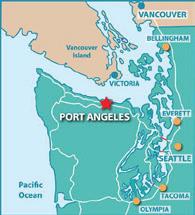




The highly anticipated and hotly contested 48° North Top 25 is back! In 2022, sailboat racing in the Pacific Northwest had the fullest racing calendar and the most participation in several years. The teams that make up this list have sailed consistently well, and frequently — nine of the

top ten boats sailed more qualifying races than the five that counted toward their scores.
How do we select these boats? The qualifying races for our Top 25 offer a good representation of keelboat racing in the Pacific Northwest, and include a mix of distance and aroundthe-buoy races, single-race events and multi-race regattas. Our scoring system is on a percentage basis, depending on the size of the class: 0% (did not finish) to 100% (first in class), where the event score = (Finishers – Place) / (Finishers – 1). Overall scores are an average of a boat’s best five finishes. There is no minimum number of races required to qualify. Multi-race events (like the Southern Sound Series) are scored as single events. For the full list of qualifying races for 2023, please check out 48° North’s Seattle Area Racing Calendar (SARC) in print or online (48north.com/sarc).
The crew of this year’s #1 boat, the J/111 Hooligan, is led by Jay Renehan and Chris Lanzinger, who represent Seattle Yacht Club. For some events, Hooligan was co-skippered by Jay and Chris; for others, it was skippered by one or the other. They sailed in seven qualifying events, and finished first in their class in four of those events. Incredible job, Hooligan team!
Congratulations to every one of 48° North’s Top 25 racing sailboats! It is always a privilege to present the list and we offer our admiration and appreciation for those in the racing community who live it and love it, and sail so well.
Photos courtesy of Jan Anderson
























Last month, we started at the end (of the year, not the project), recapping our Jeanneau SunFast 3300 (SF3300) Red Ruby’s last race in 2022, the Rolex Middle Sea Race. This month we are going to step a little bit farther back to the fall of 2021 and the genesis of the Red Ruby Project. After returning from Italy in September — where my wife and sailing partner, Chris, and I had just competed in the Mixed Doubles Offshore World Championships in Figaro 3s — we had the good fortune to spend an evening with Ron Rosenberg and Jonathan McKee. We spent several hours reviewing the event and then talking about what might be next for us. We wanted to do more doublehanded distance races, and were excited about many of the classic distance races around the world (Fastnet, Middle Sea Race, Caribbean 600, Sydney
Hobart, among others). That meant primarily racing outside of the U.S. To do that, we needed a boat. Chartering didn’t have appeal, as we were concerned about being able to prepare the boat to the level we envisioned. Buying a boat didn’t seem practical since we would, at most, be able to use the boat three to five times per year. Partnering on a boat though? That seemed promising, and so we set the idea on simmer.
A few months later, Chris and I learned of the UK Doublehanded Offshore Series (UKDHOS). For 2022, that would be a six-race series with the top four races used for a boat’s end of season score. The races were all distance races (mostly overnight) ranging in distance from 75 to 230 nautical miles. Several things about the series appealed to us. In 2021, each race was getting 30+ doublehanded entries, and all of the boats were similar in size and rating. Also, there were a lot of SF3300s in the fleet, which we were interested in.

We shared what we had learned with Ron and Jonathan, highlighting the fact that racing a SF3300 in the UK would be a way to get up to speed quickly, since
we would have instant feedback on performance with so many sisterships on the race course. That seemed particularly important given the limited time we could realistically commit to sailing a boat in Europe. The UK was becoming a magnet for SF3300s, growing a fleet of more than 20.
Many 48° North readers probably know this already, but Jonathan has a lot of shorthanded sailing experience (Mini Transat and Barcelona World Race for starters), and he is keen on continuing to do more shorthanded, particularly doublehanded, races in interesting places. Tah dah! A solution to the boat problem — a 50/50 partnership with Jonathan. We spent the 2021 holiday season looking for the right boat, which we quickly narrowed down to a used (2020) SunFast 3300 located in Hamble, UK, which is, not coincidentally, ground zero for the UKDHOS.
By the end of January 2022 we had a competitive boat, renamed Red Ruby, sitting on the hard, waiting for our next move. We also had a very appealing team to campaign Red Ruby. Jonathan would be partnering with Alyosha

Strum-Palerm, one of Seattle’s brightest young sailors who has sailed a lot with Jonathan, including notching an R2AK win together in 2022, followed by a great performance in the Pacific Cup together on the Riptide 41, Blue. Chris and I would compete together, having raced doublehanded together for more than 25 years. Effectively, we were setting up two campaigns using the same boat.
From the outset, we have been able to capitalize on the skillset and enthusiasm that the team brings to the table, and we are building on our individual and shared experiences with race debriefs and analysis. As an example, all of us bring an analytical approach to making a boat go fast. This is aided by Jonathan’s amazing ability to evaluate rig tune and sail shape, and the rest of us are super eager to absorb that knowledge. We all enjoy digging into the details and believe in rigorous preparation, which, no surprise, is a big benefit when you are trying to campaign a boat remotely.
Chris is the supreme campaign director, making sure that we arrive at a race with no loose ends, ready to focus
on the boat and the race. Alyosha, in addition to his youthful energy, brings an eye for the details of boat preparation and sail handling, honed from his time as a successful high school sailing coach, and the decision to enthusiastically dive into keelboat racing as a young teenager.

I went to grad school in meteorology, so we all feel pretty good about our pre-race planning, routing, and strategy. Jonathan says, “It feels more like a 4-person team than two 2-person teams, and I think that is pretty unique in the sailing world.”

It is that team dynamic that has made year one of the Red Ruby project a success.
But why name the boat Red Ruby? Red Ruby is named after the Pacific Northwest’s smallest octopus, the Red Ruby Octopus (Octopus rubescens). These animals are quite intelligent, can change the color of their skin to camouflage themselves, and make their home in rocky intertidal areas. We wanted to name the boat after an inspiring marine animal living in the Salish Sea — a tribute to our Pacific Northwest origins while competing in far flung parts of the world.
Stay tuned for more stories from Red Ruby. Next month, we’ll discuss the details of getting Red Ruby ready for the 2022 UKDHOS and beyond.

The Duwamish Head Race always ushers in a new year of racing, and it did once again on the first Saturday of January, 2023. Hosted by Three Tree Point Yacht Club (TTPYC), the Duwamish Head Race is the second stop on the four-race Southern Sound Series (SSS). The race begins and ends in front of Des Moines Marina, and sends racers north to Duwamish Head, across to Blakely Rock, and back.
As is the case with all the SSS races, the hosting club recognizes the effort and time boats undertake to participate in a winter regatta that is away from home for many sailors. For Duwamish Head, TTPYC sponsors free moorage at the marina, provides food and drinks the night before and the morning of the race, and has a team on the dock to help race boats get in and out easily. In 2023, at least 16 race boats took advantage of this hospitality.
The forecast both Friday night and Saturday morning called for a southeast breeze of 5-6 knots, backing to northeast and dwindling over the course of the day. Thus, it came as a surprise to the racers and the race committee when they were greeted with about 10 knots out of the north-northwest at the start. The 56 race boats in attendance played the good initial hand they were dealt, getting off the start line and beating pleasantly toward Alki Point.
For the race committee, the good breeze presented a slight conundrum. Based on the initial forecast, the likelihood of a shortened course had been high. But, in the actual conditions on Saturday morning, boats were making quick progress up the course. It would have to be a ‘wait and see’ call.
Dean Conti, skipper of the Jeanneau 53, Equus, says: “Getting around Alki is always a challenge.” And that’s where things got tricky for the fleet. Once they turned east at Alki to round the mark at Duwamish Head, the breeze dried up. The fleet separated in the very light breeze, as the lighter boats did better and the heavier boats struggled. The race committee again considered a shortened course as boat speeds dropped, but the fleet's advanced position and the early time of day led them to stick with the full course.
Once around the mark, the reach across to Blakely Rock in the dying northerly provided just enough oomph to keep boats moving. Some were able to fly a spinnaker on the tight reach, some were not, and some that started with one had to douse it and head up as the breeze shifted west closer to Bainbridge Island.
Turning back south after Blakely, the fleet hoisted spinnakers and tried to keep them full in the northerly zephyrs and rain. The front pack of lighter boats got even farther down the course, causing more separation between the haves and the have-


The overall winners on TP52, Mist, thrived in the light conditions.
Photo by Jimmy Grant.
nots. There was a lot of lightwind jibing before the northerly evaporated completely.
As the convergence zone took hold, the boats farthest south lost breeze first, causing a bit of consolidation. But when the breeze did fill, it was from the southwest, ensuring the lead pack would finish first.
Eventually that southerly filled to a wide range of 0-18 knots, with some big growlers making things interesting for the later finishers. Many elected to retire as the sun went down. In the end, 31 of the 56 boats that started the race completed the course.
Being a day that appealed to the light and quick, TP52 Mist, won their class and the overall. Around the fleet, class wins went to Farr 30, Nefarious; J/35 Grace E; Evelyn 32, Ratfish; J/29, Slick; and Cal 40, White Squall. Congrats to all the racers, and thanks to the hosts from TTPYC — 2023 racing is officially started!
By Joe Cline and Dean ContiSearching for puffs in the dwindling breeze near Alki Point.
Photo by Jimmy Grant.
No amount of high-end rain gear will make Seattle sailing feel like California. So, for our winter season this year, we hung up our heaviest foulies and went to California.
As the Northwest works to become a more competitive district, going to sail against top teams from other regions is a must, and it is a lot of fun, too. In January, six high school teams from the Pacific Northwest attended the Rose Bowl Regatta hosted by the Pacific Coast Interscholastic Sailing Association (PCISA). The two day event in Long Beach drew 78 teams from around the country, including Pacific Northwest high school teams from Bainbridge Island, Orcas Island, Olympia, Capitol, Gig Harbor, and Lakeside.
For teams who were not accustomed to beach launching boats, the sand was a nuisance and the high surf warning was a bit sporty, to say the least. On the second day, one rig was damaged when the breakers on shore sent boats ripping into the beach and bowled over any sailors in their path. Throughout the weekend, many rudders, hulls, and centerboards received an involuntary sand blasting.
The regatta was sailed in Club Flying Junior dinghies, and fleets were divided into gold, silver, and bronze divisions, based on the team’s experience and national standing. The top schools in the gold and silver fleet were predominantly





from Southern California with our PNW teams coming in midfleet, but in bronze, the second through fifth place teams were all from Washington. There’s always room for growth, but the Northwest sailors still held their own.
The winter trip to Long Beach for the Rose Bowl was a great experience for our next generation of racers, and another step towards the Northwest becoming a more competitive district.
DUTCH CANAL BARGE IN FRANCE Half interest for sale. 13.7 meters. Full solar system. 75 hp. Mercedes Diesel, apartment size reefer, shower, head, 2 new bilge pumps, updated electrical system, diesel furnace, 200 liters fuel, 200 liters water. recent haulout 4 year old survey, lots of photos. » Contact Pat Murphy • (208) 481-1843 • africaworks.murphy@gmail.com • $35,000

‘91 SCHOCK 35 SAILBOAT Quality racer/cruiser. Well maintained, upgraded. Bottom foils faired/painted 2018. Diesel htr, hot water, refer/freezer. Furuno Navnet chart plotter GPS, AIS. Digital charts Vancouver Is. to Oregon. Radar, autopilot. Dodger + Bimini covers. Perkins M30 eng. Flexifold 3 blade prop. Full set sails w/ cruising genaker. Lying Brownsville. » Contact John Burton • (360) 731-2461






McKie W. Roth Jr design. LOA 44,LOD 32’8, Beam 10’3” Full keel, Honduras mahogany planks on White Oak frame, Teak decking, Handsome interior. Sitka Spruce masts recently rebuilt. New standing rigging by Brion Toss. New Carol Hasse main sail. New Volvo Penta diesel 40 HP. Located in Everett, WA. Recent survey available. Needs some work, ideal for a wooden boat carpenter or student. » Contact Mary Wood • (360) 628-6949 • marydwood@gmail.com • $35,000
PERRY RELIANCE 37 Built to the highest standard and maintained as such this Perry Designed and Canadian Built boat is outfitted for long distance cruising in mind. Currently cruising back to Astoria from a solo winter cruise down to San Diego. New: Stainless NFM opening portlights, B&G Radar/Chartplotter, Isotherm 12V refrigerator/freezer, wind/spd/depth/autopilot/ hydrovane, D400 wind, H2O maker, sails, rigging. » Contact JC • happycampersailing@protonmail.com • (971) 344-7785 • $85,000
$35,000
1978 NORTH SEA 34 PILOTHOUSE
Comfortable cruiser and NW veteran. Dual helms. Yanmar3GM 30 engine with Autoprop 2- 30 gal aluminum fuel tanks. Pressure hot and cold H20, propane oven, heater. engine heat, Newer 130% Genoa & Harken furling system. Main sail in good condition. Bruce anchor manual windlass. Bottom sider cockpit cushions. Radar & GPS. Moorage available.
» Contact Douglas W. Davidson • (425) 864-1955
• ddavidson@pumptechnw.com • $35,000


Marie Anne, a Friendship Sloop; they originally were gaff rigged fish boats in Maine. Mahogany planking, twocylinder Yanmar, sails, interior and cockpit cushions winches. The owner, now deceased, worked out of state for eleven years. The boat was in saltwater storage, under cover in Seattle. This is a boat for someone who loves a historic type vessel and can fix her up.
» Contact Paul Kelton • pkeltop@gmail.com • $3,500 (Negotiable)
LUXURY SAILING CHARTER BUSINESS FOR SALE IN THE SAN JUANS
Highly successful crewed charter business with established history of full seasons and satisfied clients. Immaculate 5 stateroom sailing yacht with USCG Coastwise Trade endorsement, beautiful website, fabulous reviews. Outstanding turnkey business!

425-443-2322 stephen@ibainc.com
Love to sail? Make a great living in the San Juan islands running a fantastic charter business! After 34 years it is time to sell our dream job. We have already done the hard work for you. Dedicated client base, beautiful website, five star reviews. Outstanding modern 55’ sloop with moorage. Great income if you are ready to take the helm of the best job in the world!
islandsailor600@gmail.com
$4,200
FOR THE SAILORS WHO ARE DREAMING TO SAIL AROUND CAPE HORN, BUT HAVE ONLY TWO WEEKS OF VACATION TO SPEND Cape Horn to sailors is what Mt. Everest is for climbers. Among millions of people who sail only a few have rounded Cape Horn. A lot have wanted to, but never got the chance, because it’s usually a lot of money and months of preparation and getting there. Here is your chance to fulfil your dream. Significant blue water sailing experience or off shore racing preferred. » Contact Vladimir Chepurnoi
• Sail.Paganel@gmail.com
• $4,200
We are hiring for various educator roles to work with youth aged 5 all the way up to adults! Spring and Summer seasons, get out on the water while providing a fun, inclusive, and safe atmosphere for learning. Positions are based out of Port Townsend and Seattle, WA. If you're passionate about what we do and eager to learn more, we'd like to meet you!
» Full descriptions on our website at nwmaritime.org/about/job-opportunities/
21 days in Antarctica on two sailboats: a primeval world of glaciers and shimmering sapphire blue icebergs. Mountains, straits, fjords, whales, elephant seals, penguins, albatrosses, and ice shelves sparkling in the rays of the Antarctic sun – all these unique sites are to be seen on this land of ice!


Details: https://paganel-sailing.com. Start on 02/12/2024 » ContactVlad Chepurnoi • Sinilga4@gmail.com • $8,630

SLOOP TAVERN YACHT CLUB 2442 NW Market St. #94, Seattle, WA 98107
“Established in Ballard since 1976” $90 Annual Dues - Reciprocal Moorages High quality sailing at the lowest cost For more info, visit www.styc.org
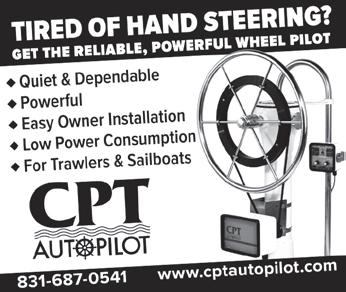
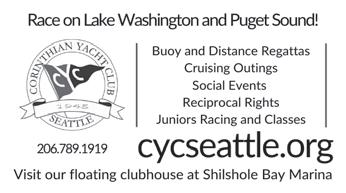





Basic through Advanced Sailing Lessons Week-long Cruise & Learn lessons Spinnaker, Intro and Advance Racing Classes

Gill foulweather gear & Dubarry footwear 206-782-5100 www.seattlesailing.com info@seattlesailing.com
7001 Seaview Ave NW Suite 130 (Shilshole Bay Marina in Port of Seattle Building)
American Sailing Association courses Basic Keelboat





37’ TAYANA 37 ’77 $59,500
HERON”
31’ PEARSON 31-2 ’89 $38,000 “SATVA” Fast boat with ample sail area proportioned into a powerful rig. Contemporary hull. Very clean vessel.
23’ JBOATS J70 ’16 $31,500

“JUST US” Fun, fast sailing. Stable boat that everyone can enjoy. All carbon mast and boom. Spirited performance!

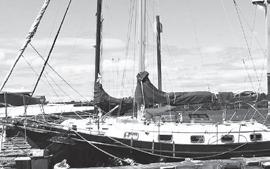

THINKING OF SELLING YOUR BOAT? LET US HELP!




31’ HUNTER 31 ’84 $34,500 “JUSTINE” Perfect entry level daysailer/ coastal cruiser. Easy to sail. Spacious interior with plenty of headroom.

Power or Sail, we have buyers waiting! Call: 619.224.2349 or email: info@yachtfinders.biz Call our Pacific NW area agent Dan: 360.867.1783

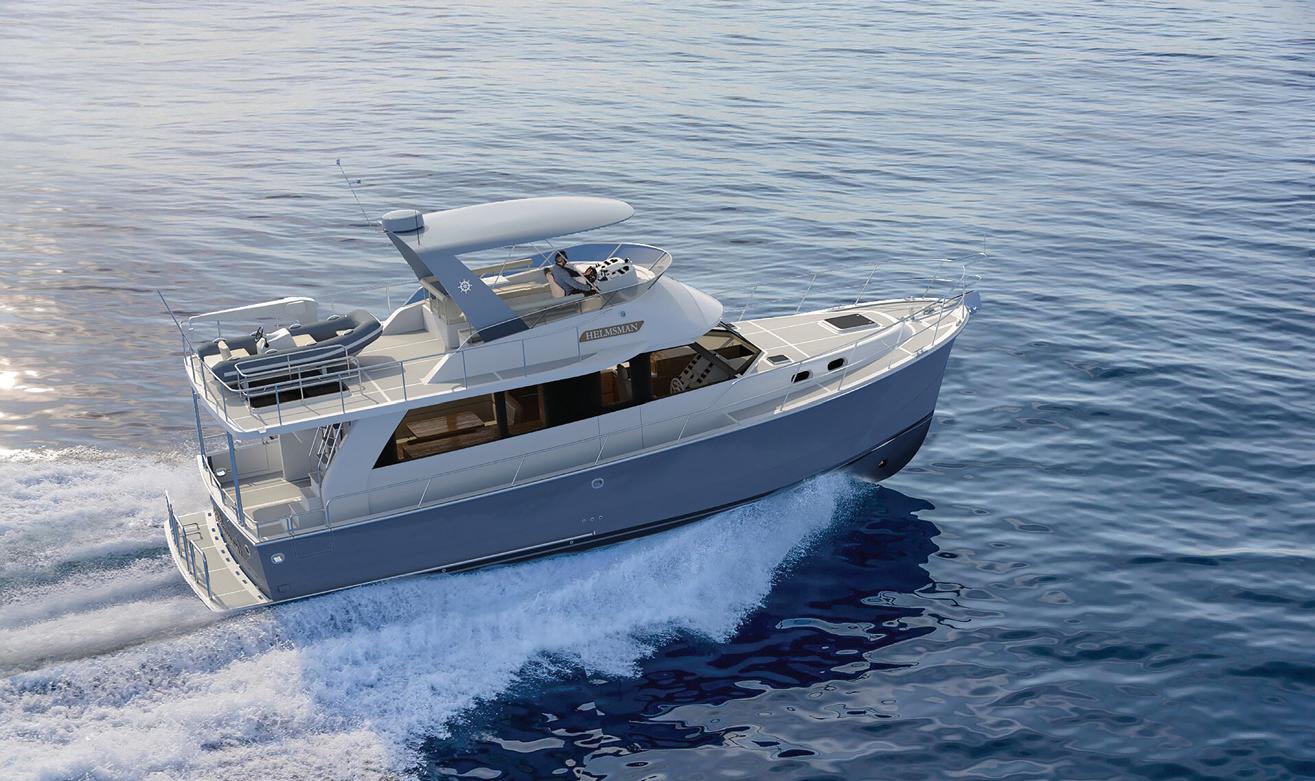


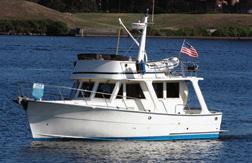

























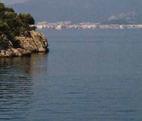















Ardent is an excellent example of a well-maintained blue water cruising yacht. She was designed by Bill Dixon of Dixon Yacht Design and built by Marine Projects (Plymouth) Ltd formally Moody Yachts (A. H. Moody & Sons). Her three-cabin, two-head layout allows for a family to cruise with plenty of room aboard for everybody. She has the overall length to accommodate her center cockpit design, allowing the galley to be included in the main saloon. Wide side decks, electric winches and the cutter rig with furling genoa and staysail make for comfortable sailing and easy sail handling, even with a shorthanded crew. Ardent has continually been upgraded and serviced since the current owner’s purchase in August of 2019. She is an excellent value for a recently upgraded, high quality three-cabin cruising yacht.
